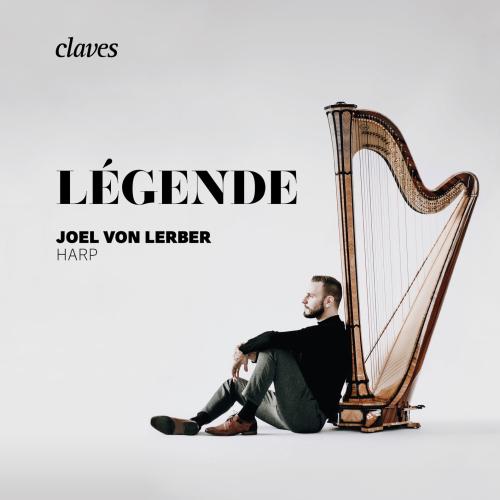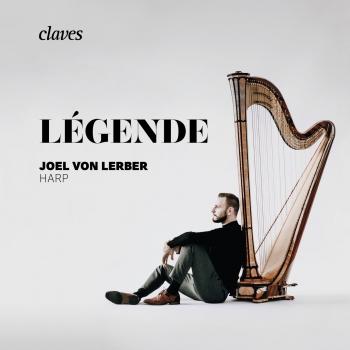
Légende Joel von Lerber
Album info
Album-Release:
2022
HRA-Release:
27.05.2022
Label: Claves Records
Genre: Classical
Subgenre: Instrumental
Artist: Joel von Lerber
Composer: Henriette Renié (1875-1956)
Album including Album cover Booklet (PDF)
- Gabriel Fauré (1845-1924): Une châtelaine en sa tour, Op. 110:
- 1 Fauré: Une châtelaine en sa tour, Op. 110 05:14
- Marcel Grandjany (1891-1975): The Colorado Trail, Fantaisie for Harp, Op. 28:
- 2 Grandjany: The Colorado Trail, Fantaisie for Harp, Op. 28 04:06
- Henriette Renié (1875-1956): Danse des lutins:
- 3 Renié: Danse des lutins 03:43
- Wilhelm Posse (1852-1925): Variationen über "Der Karneval von Venedig":
- 4 Posse: Variationen über "Der Karneval von Venedig" 10:02
- Henriette Renié: Légende d‘après "Les Elfes" de Leconte de Lisle:
- 5 Renié: Légende d‘après "Les Elfes" de Leconte de Lisle 10:53
- Elias Parish Alvars (1808-1849): La Mandoline, Op. 84:
- 6 Alvars: La Mandoline, Op. 84 07:43
- Mikhail Mchedelov (1903-1974): Variationen über ein Thema von Paganini:
- 7 Mchedelov: Variationen über ein Thema von Paganini 12:54
- Franz Liszt (1811-1886): Le Rossignol S. 250/1 (Arr. for Harp by Henriette Renié):
- 8 Liszt: Le Rossignol S. 250/1 (Arr. for Harp by Henriette Renié) 04:39
- Nicolas-Charles Bochsa (1789-1856): Rondeau sur le trio « Zitti zitti » du Barbier de Séville de Rossini:
- 9 Bochsa: Rondeau sur le trio « Zitti zitti » du Barbier de Séville de Rossini 07:19
Info for Légende
The French instrument maker Sébastien Érard was significantly involved in the modern harp’s development. In 1810, he patented the fully chromatic double-action harp. Thanks to the instrument’s seven pedals and a sophisticated mechanism, it was now possible to change the string lengths and raise each note up to two semitones. This enabled the harpist to play in all keys without retuning the instrument. Composers such as Richard Wagner, Gustav Mahler and Claude Debussy took advantage of these new possibilities and established the harp as an orchestra instrument. In his “Treatise upon Modern Instrumentation and Orchestration” (published in 1844), Hector Berlioz claimed that the harp should never be placed behind the orchestra.
The harp was also brought to the foreground as a solo instrument in classical music repertoire. The French harpist Henriette Renié (1875 – 1956) played a significant part in this popularity. Thanks to her highly virtuoso playing, her own compositions and arrangements of pieces by other composers, she decisively influenced the music for harp solo at the beginning of the 20th century. She also inspired other composers (including Claude Debussy and Maurice Ravel) to write works for the harp and was a much sought-after teacher with many successful pupils. In 1914, she launched the “Concours Renié”, the first international harp competition. In her own works, Henriette Renié often dealt with fantasy topics. Such is the case in the Légende d’après «Les Elfes» de Leconte de Lisle, which she wrote in 1901 after a poem by French author Leconte de Lisle. The text is about a black knight riding at night through the forest in search of his bride. He encounters malevolent elves that try to seduce him. When they fail, they kill the knight’s fiancée. The knight then also dies out of desperation and love. The Légende pointedly begins with the harp’s lowest note, which keeps on reappearing in the following bars like an urgent reminder. An incisive scale in unison follows it. This is the starting point of a partly descriptive musical programme. The horse’s galloping and the elves’ nimble movements are just as perceptible as the eerie atmosphere of the dark forest, the treachery of the elves and the last breathe of life. In the final bars, the low note is heard once again. It now announces the tragic end like a death knell. In her Légende, Henriette Renié greatly expanded the harp’s sound range, masterfully using all the instrument’s possibilities. Her precise performance instructions and the tremendous technical challenges on the performer are striking. Renié’s virtuoso Danse des lutins (Dance of the Goblins, composed in 1911) also takes us into a fantasy world: goblins jump back and forth, do somersaults, suddenly stop and then resume their merry dance. In this piece, the harpist must have both nimble fingers and very agile feet to achieve rapid successive harmonic changes with the pedals. The Danse des lutins is reminiscent of Franz Liszt’s Gnomenreigen (Dance of the Gnomes), a composer who much influenced Henriette Renié. She transcribed some of his piano pieces for the harp, including Le Rossignol (The Nightingale). Franz Liszt wrote this piece after an eponymous song by the Russian composer Alexander Alyabyev. [..]
Joel von Lerber, harp
Joel von Lerber
is a frequent soloist with orchestras in Switzerland and Germany such as the Konzerthausorchester Berlin, the Thüringer Symphoniker and the Philharmonisches Orchester Vorpommern. He has played as well with the State Hermitage Orchestra in St. Petersburg in the Small Philharmony Hall in Russia, with the Mexico City Symphonic Orchestra in the Bellas Artes Palace in Mexico, with the Orchestra Zrbranksa in Poland and with the Haifa Sinfony Orchestra in Israel.
At the age of six, Joel von Lerber began to take harp lessons at the Music Conservatory of Bern, Switzerland. He was taught by Nathalie Chatelain and Simon Bilger. He began his academic studies in 2009 at the Hochschule für Musik in Basel, Switzerland with Prof. Sarah O’Brien and gained his Bachelor of Arts in Music with honours in June 2012. In September 2012 he took up his studies for Master of Performance at the Zürcher Hochschule der Künste in Zürich, Switzerland with Prof. Sarah O’Brien and gained a Master of Performance with honours in June 2014. In September 2014 he took up studies for Master of Music at Hochschule für Musik Hanns Eisler in Berlin, Germany with Prof. Maria Graf and gained a Master of Music with honours in June 2016. In September 2016 he continued his studies for the concert exam with Prof. Maria Graf and graduated in May 2019 with honours. His final exam in May 2019 was also his debut as a soloist with the Konzerthausorchester in the Konzerthaus of Berlin.
Joel received additional artistic guidance from different renowned harpists like Prof. Helga Storck, Isabelle Moretti, Jana Bouskova, Xavier de Maistre and from pianist Pavlin Nechev.
In 2008, he won the first prize and a special prize at the Swiss Youth Music Competition. In 2011 he was a first prize winner at the International Franz Josef Reinl-Stiftung Harp Contest. In November 2012 he was awarded the highly prestigious grant of the Migros Culture Foundation. In 2013 he won 3 prizes: in June1st prize and Audience Award at the Louis Spohr Competition in Germany, in July 6th Prize at the USA International Harp Competition in Bloomington, IN and in December he won again the highly doted Grant of the Migros Culture Foundation. In February 2014 he won a prestigous grant of DAAD for studies in Berlin, Germany, which has been renewed yearly. In September 2014 he participated in the Golden Harp Competition in St. Petersburg, Russia and won a 3rd prize. In September 2015 he participated in the Michal Spisak International Music Competition in Dabrowa Gornicza (PL) and won a 2nd prize and the special prize from the orchestra. In November 2017 he won the 2nd prize at 5th Mexico International Harp Competition. In November 2018 Joel won the 2nd Prize at the 20th International Harp Contest in Akko, Israel and 2 special awards, one for the best interpretation of Bedrich Smetana´s Moldau and another one for the best interpretation of the Israeli piece "Hed Meruchak" by Joseph Bardanashvili.
He gained additional experience as an orchestra player with the Kammerorchester Bern, with the Musikkollegium Winterthur, with the Schleswig-Holstein Musikfestival Orchestra, with the l'Orchestre de l'Opéra de Rouen, with the Sinfonia Varsovia, with the Rundfunk-Sinfonieorchester Berlin, with the Staatstheater Braunschweig, with the Philharmonisches Orchester der Hansestadt Lübeck and with musicAeterna under the baton of Teodor Currentzis.
Booklet for Légende










